fuse FORD F-53 2020 Owners Manual
[x] Cancel search | Manufacturer: FORD, Model Year: 2020, Model line: F-53, Model: FORD F-53 2020Pages: 197, PDF Size: 3.04 MB
Page 5 of 197
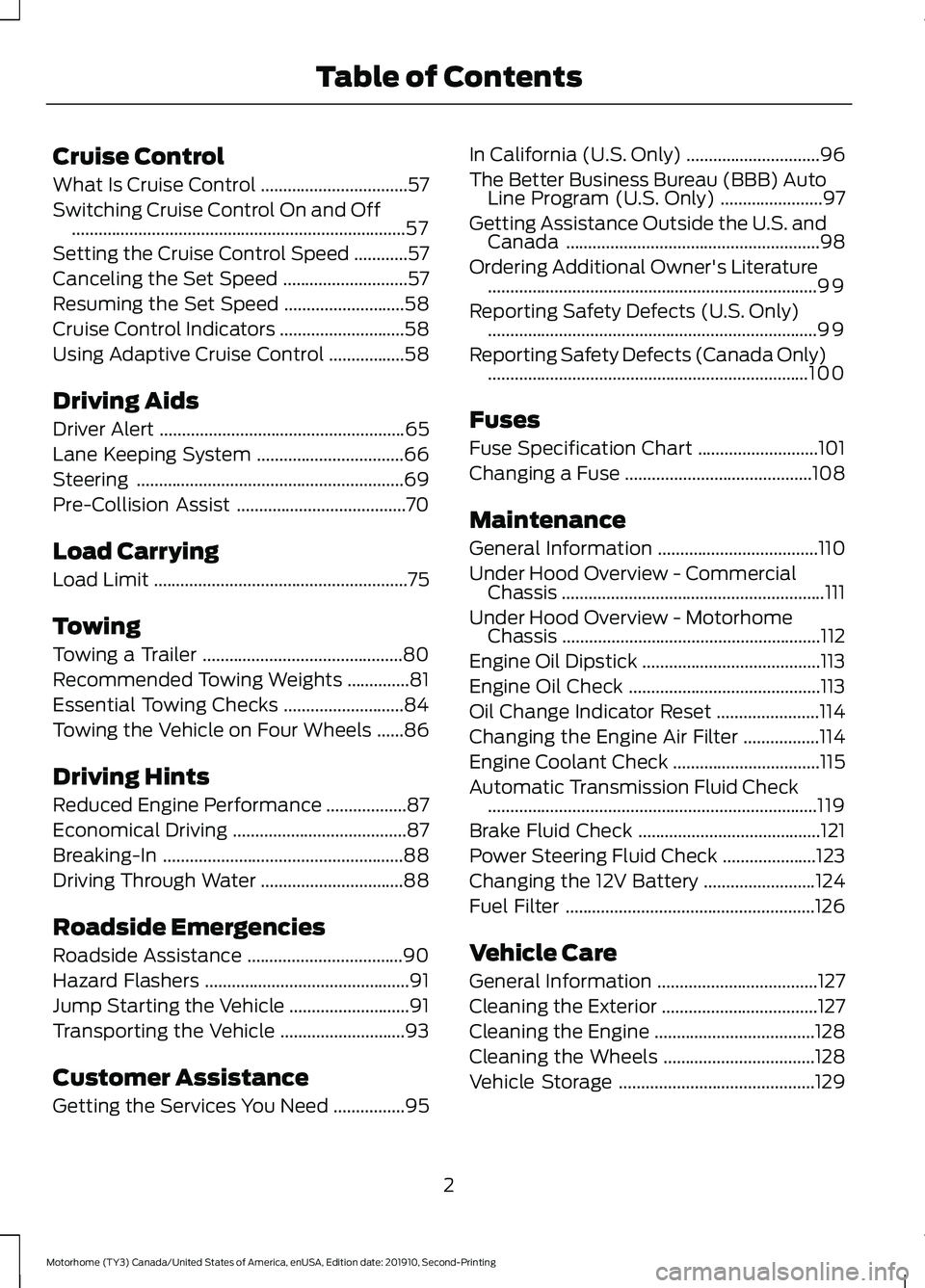
Cruise Control
What Is Cruise Control
.................................57
Switching Cruise Control On and Off ........................................................................\
...
57
Setting the Cruise Control Speed ............
57
Canceling the Set Speed ............................
57
Resuming the Set Speed ...........................
58
Cruise Control Indicators ............................
58
Using Adaptive Cruise Control .................
58
Driving Aids
Driver Alert .......................................................
65
Lane Keeping System .................................
66
Steering ............................................................
69
Pre-Collision Assist ......................................
70
Load Carrying
Load Limit .........................................................
75
Towing
Towing a Trailer .............................................
80
Recommended Towing Weights ..............
81
Essential Towing Checks ...........................
84
Towing the Vehicle on Four Wheels ......
86
Driving Hints
Reduced Engine Performance ..................
87
Economical Driving .......................................
87
Breaking-In ......................................................
88
Driving Through Water ................................
88
Roadside Emergencies
Roadside Assistance ...................................
90
Hazard Flashers ..............................................
91
Jump Starting the Vehicle ...........................
91
Transporting the Vehicle ............................
93
Customer Assistance
Getting the Services You Need ................
95In California (U.S. Only)
..............................
96
The Better Business Bureau (BBB) Auto Line Program (U.S. Only) .......................
97
Getting Assistance Outside the U.S. and Canada .........................................................
98
Ordering Additional Owner's Literature ........................................................................\
..
99
Reporting Safety Defects (U.S. Only) ........................................................................\
..
99
Reporting Safety Defects (Canada Only) ........................................................................\
100
Fuses
Fuse Specification Chart ...........................
101
Changing a Fuse ..........................................
108
Maintenance
General Information ....................................
110
Under Hood Overview - Commercial Chassis ...........................................................
111
Under Hood Overview - Motorhome Chassis ..........................................................
112
Engine Oil Dipstick ........................................
113
Engine Oil Check ...........................................
113
Oil Change Indicator Reset .......................
114
Changing the Engine Air Filter .................
114
Engine Coolant Check .................................
115
Automatic Transmission Fluid Check ........................................................................\
..
119
Brake Fluid Check .........................................
121
Power Steering Fluid Check .....................
123
Changing the 12V Battery .........................
124
Fuel Filter ........................................................
126
Vehicle Care
General Information ....................................
127
Cleaning the Exterior ...................................
127
Cleaning the Engine ....................................
128
Cleaning the Wheels ..................................
128
Vehicle Storage ............................................
129
2
Motorhome (TY3) Canada/United States of America, enUSA, Edition date: 201910, Second-Printing Table of Contents
Page 9 of 197

Battery
Battery acid
Brake fluid - non petroleum
based
Brake system
Brake system
Cabin air filter
Check fuel cap
Child safety door lock or unlock
Child seat lower anchor
Child seat tether anchor
Cruise control
Do not open when hot
Engine air filter
Engine coolant
Engine coolant temperature Engine oil
Explosive gas
Fan warning
Fasten seatbelt
Flammable
Front airbag
Front fog lamps
Fuel pump reset
Fuse compartment
Hazard flashers
Heated rear window
Windshield defrosting system
Interior luggage compartment
release
Jack
Keep out of reach of children
6
Motorhome (TY3) Canada/United States of America, enUSA, Edition date: 201910, Second-Printing Introduction E270480 E71340 E71880 E231160 E67017 E161353
Page 52 of 197
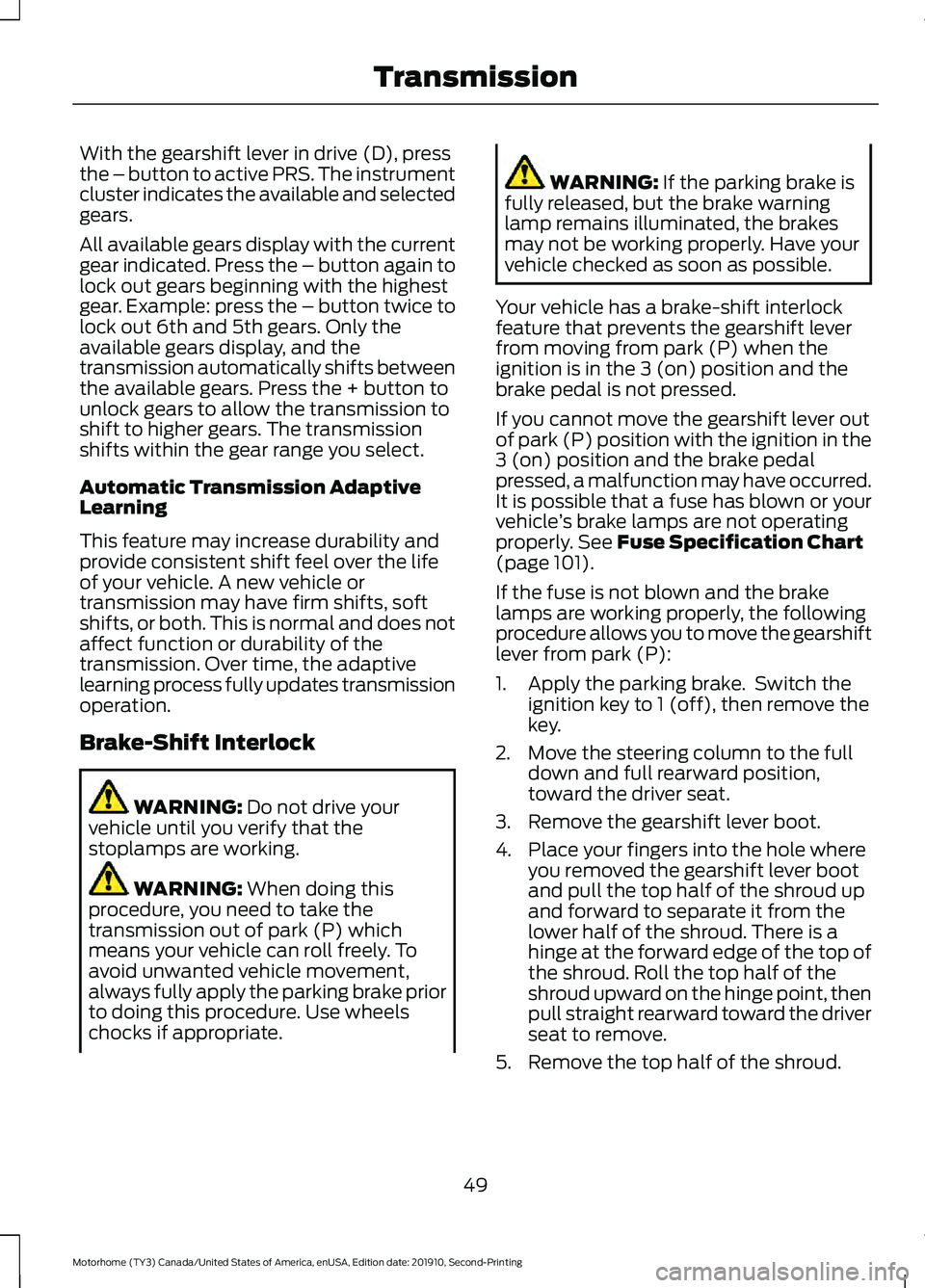
With the gearshift lever in drive (D), press
the – button to active PRS. The instrument
cluster indicates the available and selected
gears.
All available gears display with the current
gear indicated. Press the – button again to
lock out gears beginning with the highest
gear. Example: press the – button twice to
lock out 6th and 5th gears. Only the
available gears display, and the
transmission automatically shifts between
the available gears. Press the + button to
unlock gears to allow the transmission to
shift to higher gears. The transmission
shifts within the gear range you select.
Automatic Transmission Adaptive
Learning
This feature may increase durability and
provide consistent shift feel over the life
of your vehicle. A new vehicle or
transmission may have firm shifts, soft
shifts, or both. This is normal and does not
affect function or durability of the
transmission. Over time, the adaptive
learning process fully updates transmission
operation.
Brake-Shift Interlock
WARNING: Do not drive your
vehicle until you verify that the
stoplamps are working. WARNING:
When doing this
procedure, you need to take the
transmission out of park (P) which
means your vehicle can roll freely. To
avoid unwanted vehicle movement,
always fully apply the parking brake prior
to doing this procedure. Use wheels
chocks if appropriate. WARNING:
If the parking brake is
fully released, but the brake warning
lamp remains illuminated, the brakes
may not be working properly. Have your
vehicle checked as soon as possible.
Your vehicle has a brake-shift interlock
feature that prevents the gearshift lever
from moving from park (P) when the
ignition is in the 3 (on) position and the
brake pedal is not pressed.
If you cannot move the gearshift lever out
of park (P) position with the ignition in the
3 (on) position and the brake pedal
pressed, a malfunction may have occurred.
It is possible that a fuse has blown or your
vehicle ’s brake lamps are not operating
properly.
See Fuse Specification Chart
(page 101).
If the fuse is not blown and the brake
lamps are working properly, the following
procedure allows you to move the gearshift
lever from park (P):
1. Apply the parking brake. Switch the ignition key to 1 (off), then remove the
key.
2. Move the steering column to the full down and full rearward position,
toward the driver seat.
3. Remove the gearshift lever boot.
4. Place your fingers into the hole where you removed the gearshift lever boot
and pull the top half of the shroud up
and forward to separate it from the
lower half of the shroud. There is a
hinge at the forward edge of the top of
the shroud. Roll the top half of the
shroud upward on the hinge point, then
pull straight rearward toward the driver
seat to remove.
5. Remove the top half of the shroud.
49
Motorhome (TY3) Canada/United States of America, enUSA, Edition date: 201910, Second-Printing Transmission
Page 83 of 197
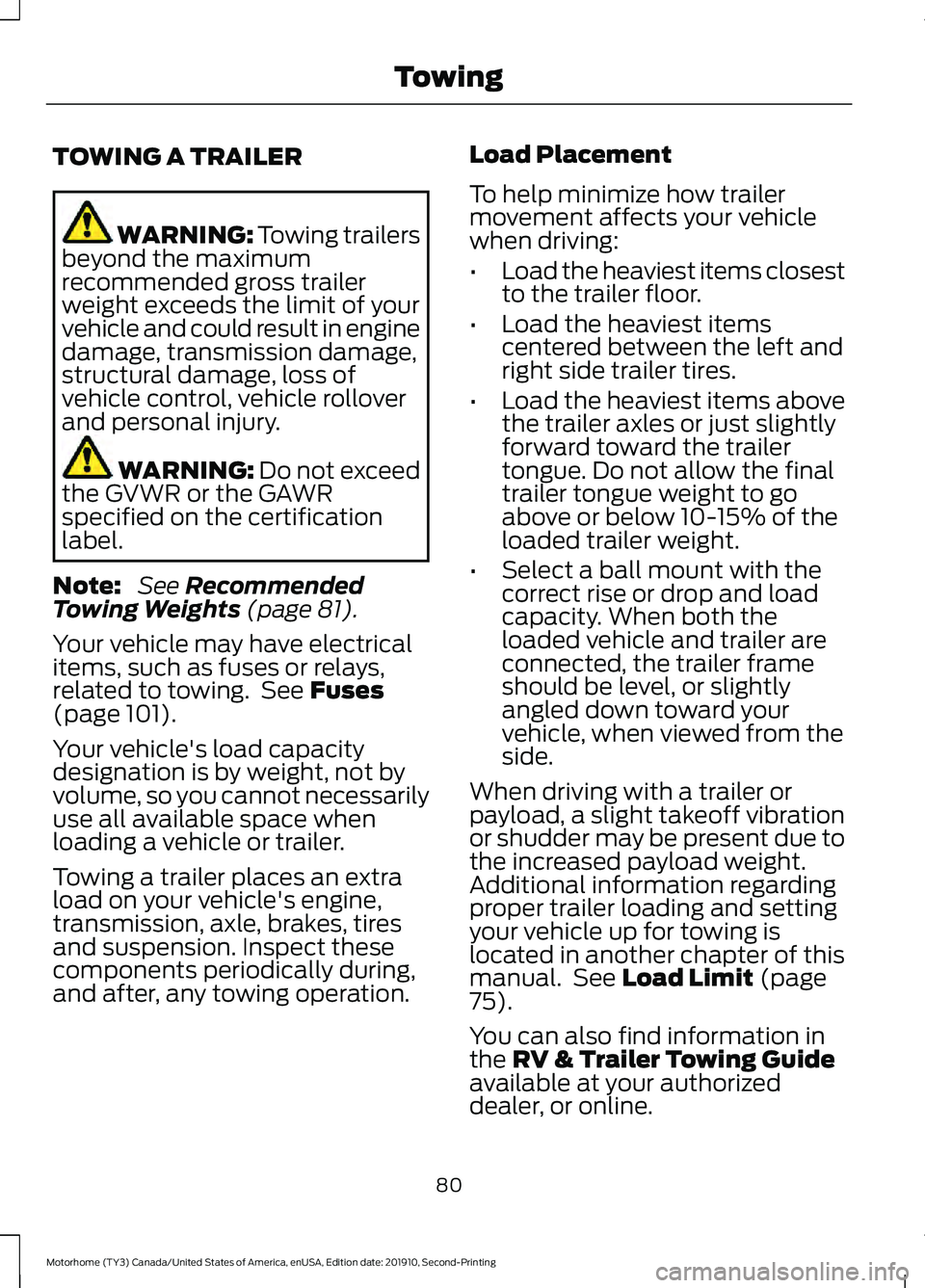
TOWING A TRAILER
WARNING: Towing trailers
beyond the maximum
recommended gross trailer
weight exceeds the limit of your
vehicle and could result in engine
damage, transmission damage,
structural damage, loss of
vehicle control, vehicle rollover
and personal injury. WARNING:
Do not exceed
the GVWR or the GAWR
specified on the certification
label.
Note: See
Recommended
Towing Weights (page 81).
Your vehicle may have electrical
items, such as fuses or relays,
related to towing. See
Fuses
(page 101).
Your vehicle's load capacity
designation is by weight, not by
volume, so you cannot necessarily
use all available space when
loading a vehicle or trailer.
Towing a trailer places an extra
load on your vehicle's engine,
transmission, axle, brakes, tires
and suspension. Inspect these
components periodically during,
and after, any towing operation. Load Placement
To help minimize how trailer
movement affects your vehicle
when driving:
•
Load the heaviest items closest
to the trailer floor.
• Load the heaviest items
centered between the left and
right side trailer tires.
• Load the heaviest items above
the trailer axles or just slightly
forward toward the trailer
tongue. Do not allow the final
trailer tongue weight to go
above or below 10-15% of the
loaded trailer weight.
• Select a ball mount with the
correct rise or drop and load
capacity. When both the
loaded vehicle and trailer are
connected, the trailer frame
should be level, or slightly
angled down toward your
vehicle, when viewed from the
side.
When driving with a trailer or
payload, a slight takeoff vibration
or shudder may be present due to
the increased payload weight.
Additional information regarding
proper trailer loading and setting
your vehicle up for towing is
located in another chapter of this
manual. See
Load Limit (page
75).
You can also find information in
the
RV & Trailer Towing Guide
available at your authorized
dealer, or online.
80
Motorhome (TY3) Canada/United States of America, enUSA, Edition date: 201910, Second-Printing Towing
Page 95 of 197
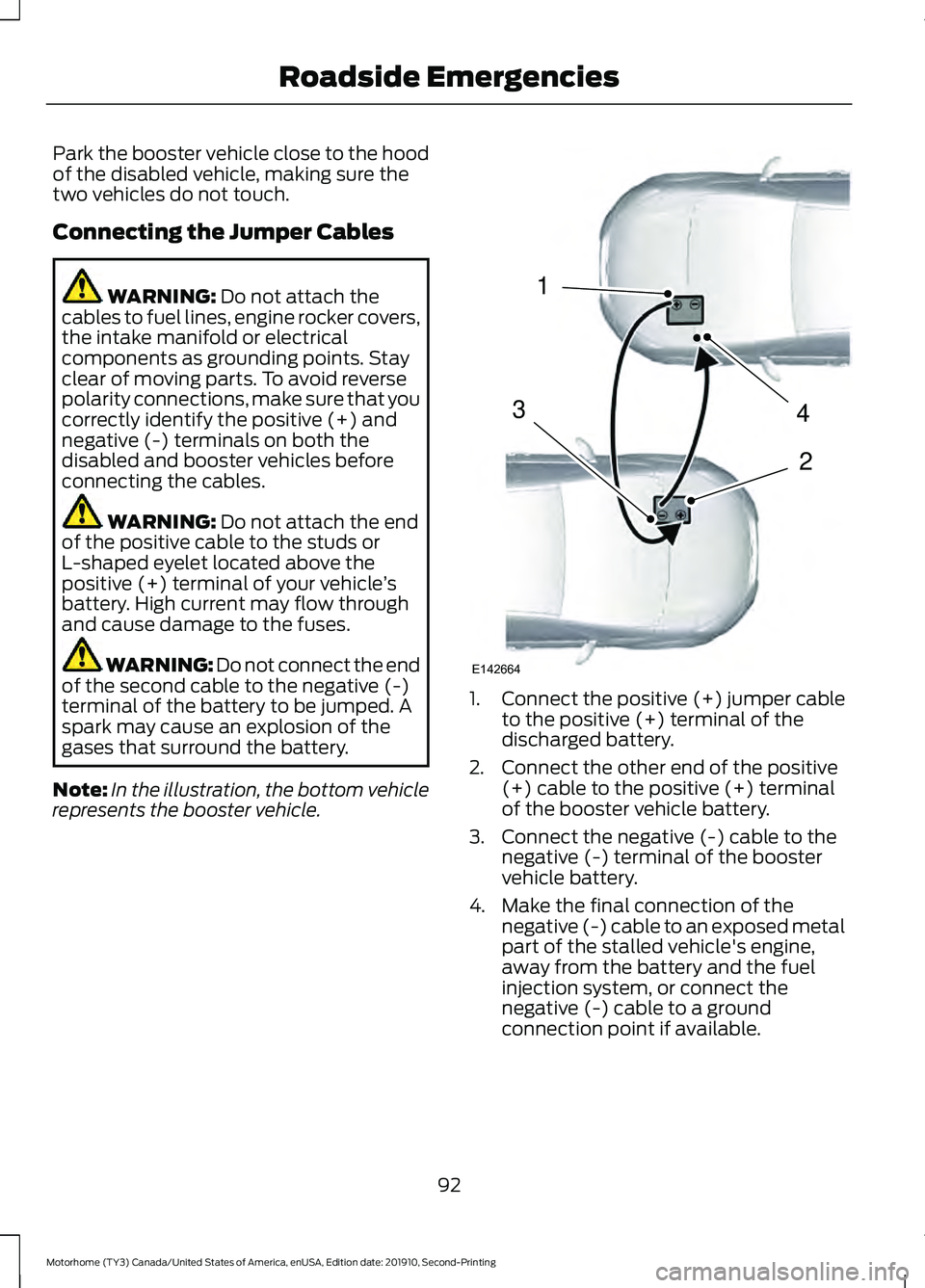
Park the booster vehicle close to the hood
of the disabled vehicle, making sure the
two vehicles do not touch.
Connecting the Jumper Cables
WARNING: Do not attach the
cables to fuel lines, engine rocker covers,
the intake manifold or electrical
components as grounding points. Stay
clear of moving parts. To avoid reverse
polarity connections, make sure that you
correctly identify the positive (+) and
negative (-) terminals on both the
disabled and booster vehicles before
connecting the cables. WARNING:
Do not attach the end
of the positive cable to the studs or
L-shaped eyelet located above the
positive (+) terminal of your vehicle ’s
battery. High current may flow through
and cause damage to the fuses. WARNING: Do not connect the end
of the second cable to the negative (-)
terminal of the battery to be jumped. A
spark may cause an explosion of the
gases that surround the battery.
Note: In the illustration, the bottom vehicle
represents the booster vehicle. 1.
Connect the positive (+) jumper cable
to the positive (+) terminal of the
discharged battery.
2. Connect the other end of the positive (+) cable to the positive (+) terminal
of the booster vehicle battery.
3. Connect the negative (-) cable to the negative (-) terminal of the booster
vehicle battery.
4. Make the final connection of the negative (-) cable to an exposed metal
part of the stalled vehicle's engine,
away from the battery and the fuel
injection system, or connect the
negative (-) cable to a ground
connection point if available.
92
Motorhome (TY3) Canada/United States of America, enUSA, Edition date: 201910, Second-Printing Roadside Emergencies4
2
1
3
E142664
Page 104 of 197
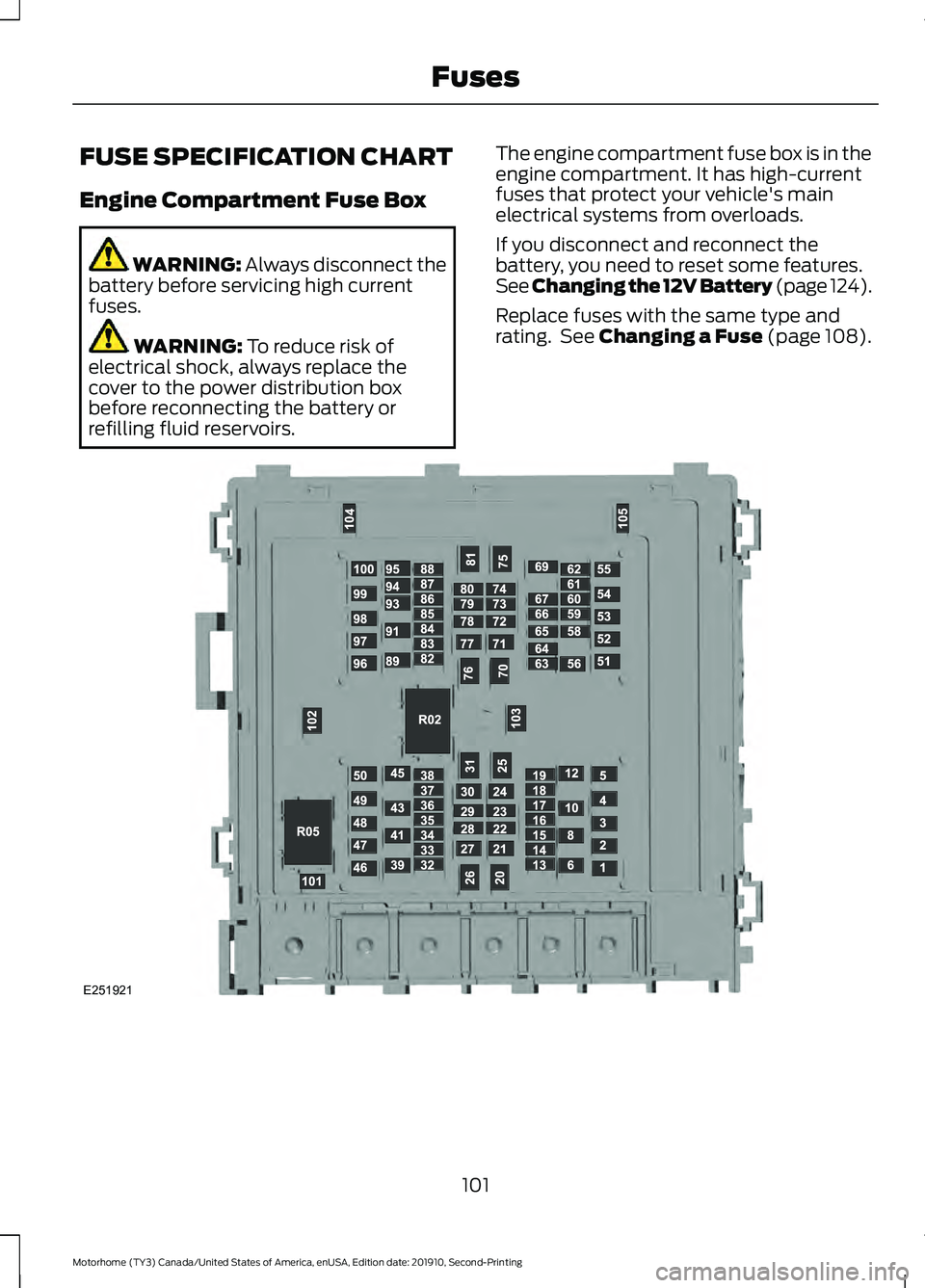
FUSE SPECIFICATION CHART
Engine Compartment Fuse Box
WARNING: Always disconnect the
battery before servicing high current
fuses. WARNING:
To reduce risk of
electrical shock, always replace the
cover to the power distribution box
before reconnecting the battery or
refilling fluid reservoirs. The engine compartment fuse box is in the
engine compartment. It has high-current
fuses that protect your vehicle's main
electrical systems from overloads.
If you disconnect and reconnect the
battery, you need to reset some features.
See Changing the 12V Battery (page 124).
Replace fuses with the same type and
rating. See Changing a Fuse (page 108).
101
Motorhome (TY3) Canada/United States of America, enUSA, Edition date: 201910, Second-Printing FusesE251921
Page 105 of 197
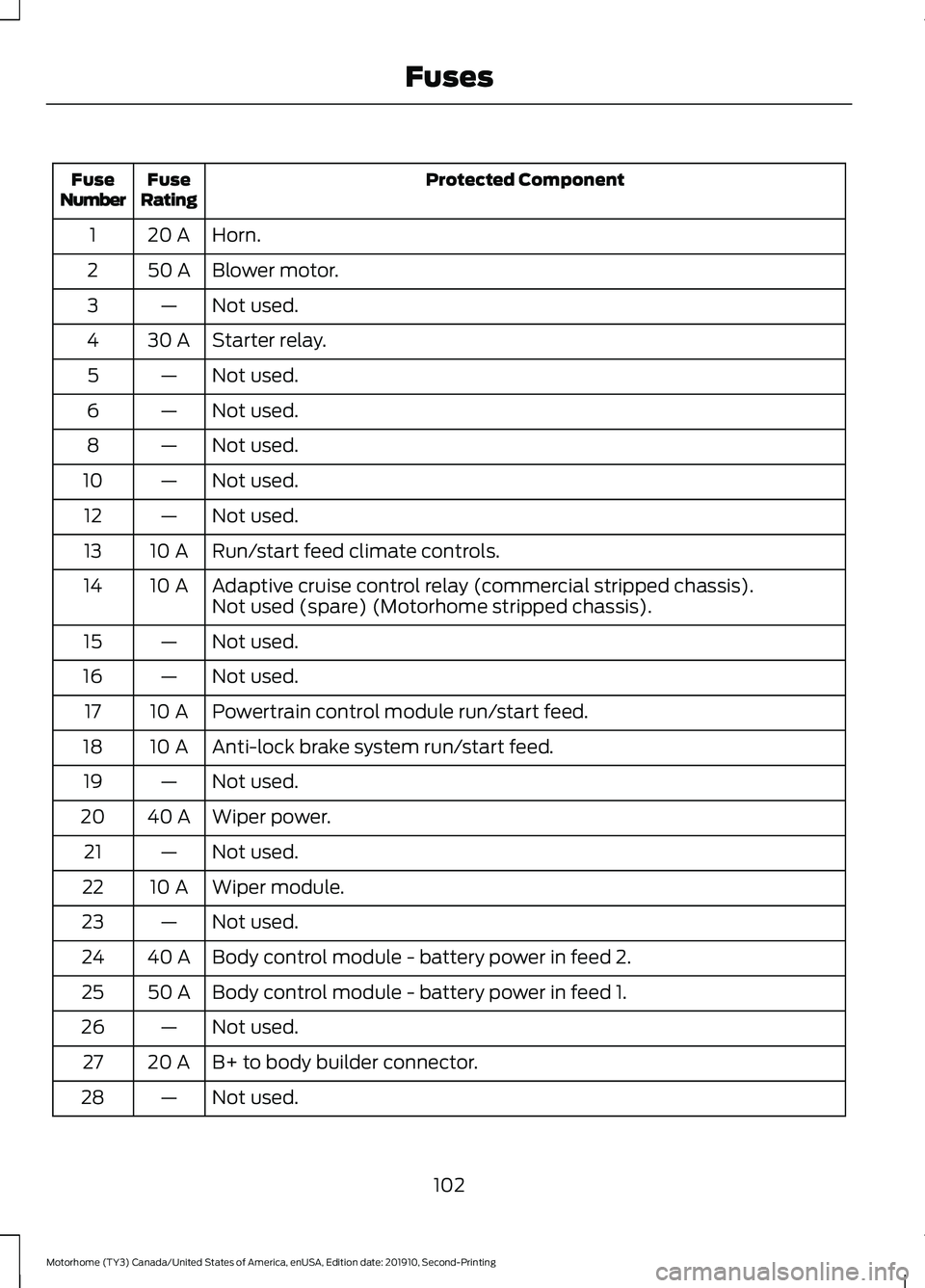
Protected Component
Fuse
Rating
Fuse
Number
Horn.
20 A
1
Blower motor.
50 A
2
Not used.
—
3
Starter relay.
30 A
4
Not used.
—
5
Not used.
—
6
Not used.
—
8
Not used.
—
10
Not used.
—
12
Run/start feed climate controls.
10 A
13
Adaptive cruise control relay (commercial stripped chassis).
10 A
14
Not used (spare) (Motorhome stripped chassis).
Not used.
—
15
Not used.
—
16
Powertrain control module run/start feed.
10 A
17
Anti-lock brake system run/start feed.
10 A
18
Not used.
—
19
Wiper power.
40 A
20
Not used.
—
21
Wiper module.
10 A
22
Not used.
—
23
Body control module - battery power in feed 2.
40 A
24
Body control module - battery power in feed 1.
50 A
25
Not used.
—
26
B+ to body builder connector.
20 A
27
Not used.
—
28
102
Motorhome (TY3) Canada/United States of America, enUSA, Edition date: 201910, Second-Printing Fuses
Page 106 of 197
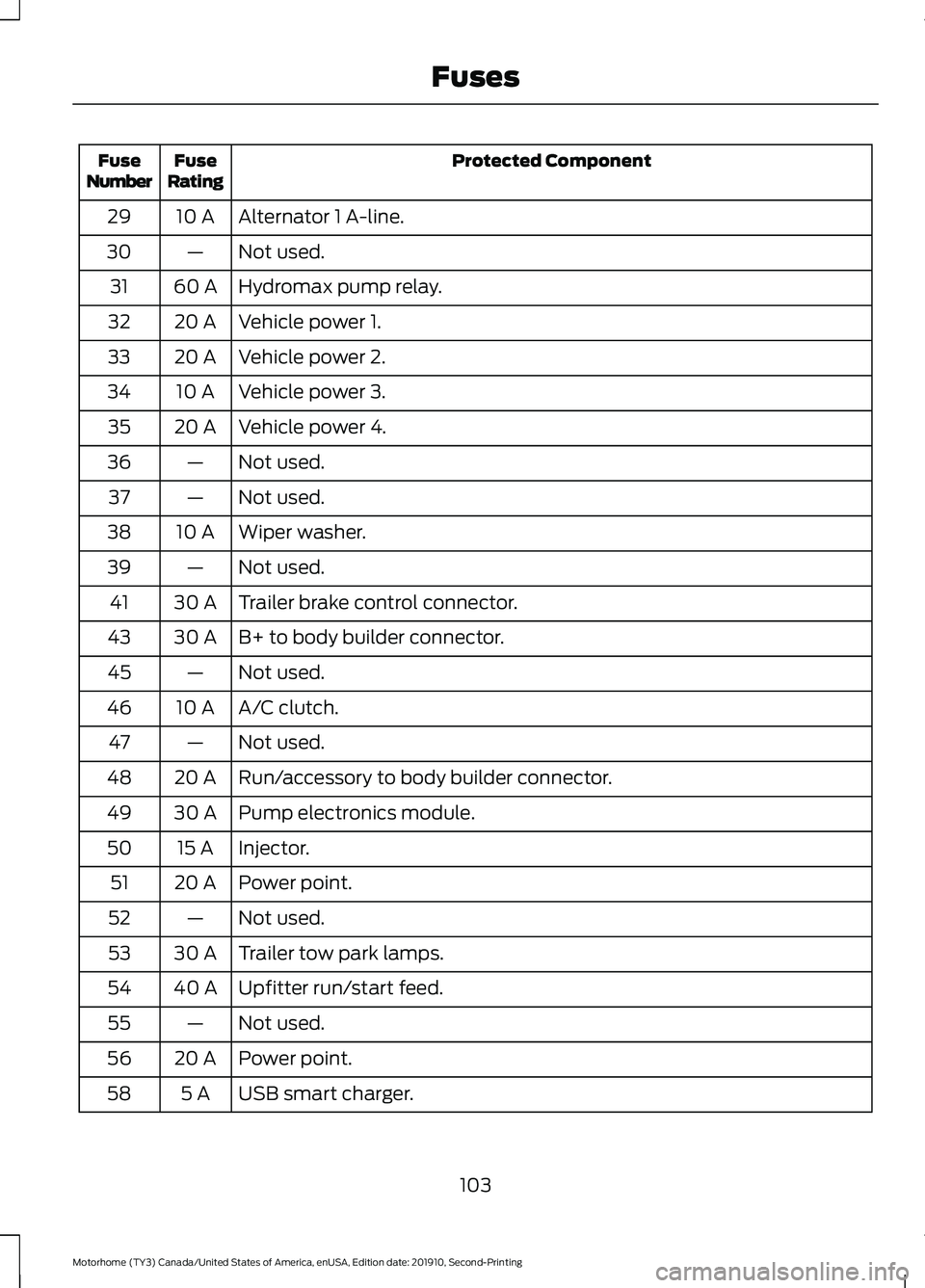
Protected Component
Fuse
Rating
Fuse
Number
Alternator 1 A-line.
10 A
29
Not used.
—
30
Hydromax pump relay.
60 A
31
Vehicle power 1.
20 A
32
Vehicle power 2.
20 A
33
Vehicle power 3.
10 A
34
Vehicle power 4.
20 A
35
Not used.
—
36
Not used.
—
37
Wiper washer.
10 A
38
Not used.
—
39
Trailer brake control connector.
30 A
41
B+ to body builder connector.
30 A
43
Not used.
—
45
A/C clutch.
10 A
46
Not used.
—
47
Run/accessory to body builder connector.
20 A
48
Pump electronics module.
30 A
49
Injector.
15 A
50
Power point.
20 A
51
Not used.
—
52
Trailer tow park lamps.
30 A
53
Upfitter run/start feed.
40 A
54
Not used.
—
55
Power point.
20 A
56
USB smart charger.
5 A
58
103
Motorhome (TY3) Canada/United States of America, enUSA, Edition date: 201910, Second-Printing Fuses
Page 107 of 197

Protected Component
Fuse
Rating
Fuse
Number
Not used.
—
59
Not used.
—
60
Not used.
—
61
Not used.
—
62
Not used.
—
63
Not used.
—
64
Not used.
—
65
Not used.
—
66
Brake on-off isolation relay.
10 A
67
Not used.
—
69
Not used.
—
70
Anti-lock brake system valves.
30 A
71
Not used (spare).
10 A
72
Not used.
—
73
Not used.
—
74
Not used.
—
75
B+ to body control module.
60 A
76
Voltage quality module power - body control module.
30 A
77
Trailer tow stop lamps.
10 A
78
Hydromax pump monitor.
5 A
79
Trailer tow backup lamps.
10 A
80
Not used.
—
81
Not used.
—
82
Not used.
—
83
Not used.
—
84
Not used.
—
85
104
Motorhome (TY3) Canada/United States of America, enUSA, Edition date: 201910, Second-Printing Fuses
Page 108 of 197

Protected Component
Fuse
Rating
Fuse
Number
Not used.
—
86
Not used.
—
87
Not used.
—
88
Not used.
—
89
B+ to body builder connector.
40 A
91
Not used.
—
93
Not used.
—
94
Stop lamp relay.
20 A
95
Trailer brake controller.
Not used.
—
96
Not used (spare).
50 A
97
Trailer tow battery charge.
30 A
98
Not used.
—
99
Not used.
—
100
Not used.
—
101
Not used.
—
102
Not used.
—
103
Not used.
—
104
Trailer tow right-hand and left-hand stop and direction indicator relay
power.
15 A
105
Note: Spare fuse amperage may vary. Protected Component
Fuse Rating
Relay Number
Powertrain control module.
—
R02
Power relay.
Not used.
—
R05
105
Motorhome (TY3) Canada/United States of America, enUSA, Edition date: 201910, Second-Printing Fuses